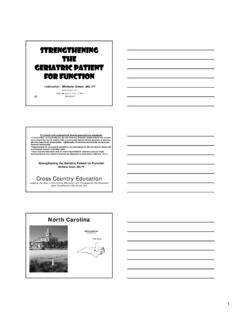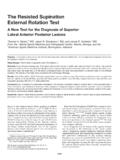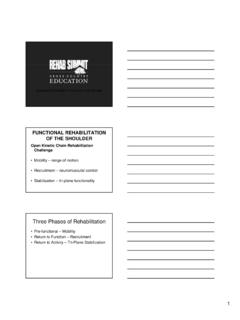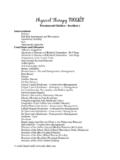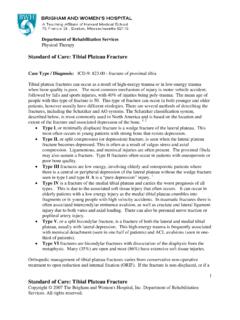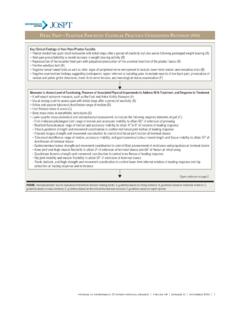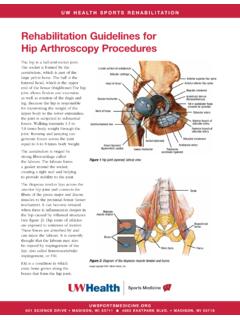Transcription of FUNCTIONAL EXERCISES FOR THE NON-WEIGHT BEARING …
1 FUNCTIONAL EXERCISES FOR THE. NON-WEIGHT BEARING PATIENT. Course Narrative 2 GOALS OF INTEVENTIONS FOR THIS PATIENT: 1. FUNCTIONAL while NBW. 2. Prepare for function when they are no longer NWB. FUNCTIONAL While NWB: The patient needs to be able to perform ADL's, transfers and mobilize through ambulation or wheelchair propulsion while they are NWB'ing. We can't change what they CAN'T do in this timeframe but we can maximize how they function with the mobility and muscles they do have. That means, how they perform everyday tasks will be different from how it was done BEFORE the injury and different from how it will be performed AFTER WB'ing restrictions are lifted.
2 IE: 45 year old construction worker falls, femur fracture, NWB left LE. Prior to injury bipedal gait (2 good legs! Very familiar, very efficient form of mobility). Now, will be reliant on UE to compensate for the one limb which can not hold the bodyweight in single limb stance phase of gait. CHANGES EVERYTHING!!!! The therapist needs to understand the new task- use of a walker to maintain NWB, needs to understand the upper body demand and teach that task through interventions in therapy. BUT . 3 months from now, WB'ing restrictions will be lifted and, assuming therapist did their job (provided HEP or interventions which address muscle activation, muscle length and core activation), patient will return to normalized, bipedal mobility.
3 FUNCTION WHILE NWB'ing = TASK ANALYSIS. Provide interventions that maximize neural adaptations and coordinated movement patterns of the muscles they do have, of the movement they do have. **DO NOT DO RANDOM EXERCISES FOR RANDOM MUSCLES THAT DO NOT ADD. TOGETHER TO CREATE A TASK THEY NEED FOR ADL's, TRANSFERS or MOBILITY!!!!! Seriously .. what benefit does overhead press with a one pound weight have to improve a patients ability to push self up from sidelying or reach behind the body to pull pants up??? NONE!
4 !!!!!! TASK ANALYSIS. Instead of looking at the body as a whole look at the task they can not complete and focus on one task at a time . You will see quicker more consistent changes when interventions are focused on addressing one task at a time. IE: If you want a child to be better at baseball .. you don't just play a game of baseball . You spend time on hitting. Correcting and practice the timing, alignment and positioning needed for that task then you focus on throwing- the timing, coordination and consistency of that task.
5 Then you practice catching, etc. YOU WOULD NEVER TEACH A CHILD BASEBALL BY LIFTING. WEIGHTS, BIKE RIDING, etc. TASK SPECIFIC DRILLS!!!!! Strengthening the muscles they do have for improved coordination and timing for ONE TASK AT A TIME!!!! This is neural adaptation. SIMPLE TASK ANALYSIS: Where does task initiate from? Success of any task we do is dependent on our ability to offer proximal control before distal mobility. If we do not have a stable base, the limb movements we attempt will be unsuccessful. Every task we perform has a point of initiation a movement proximally within the body (more specifically, the trunk) that creates the stability needed for the rest of the task.
6 Sit- stand initiates from ant pelvic tilt. WHAT IF THEY CAN NOT ACCESS THE MOVEMENT NEEDED? If they can not access it do to lack of muscle activation or ROM- Then before you continue with task training, you need to STOP and prepare the body to be successful for the task. Create an intervention that will give them the muscle activation and/or range of motion for that movement. Patient is stuck in post pelvic tilt from prolonged w/c sitting and can not get to ant pelvic tilt. The intervention the therapist gives IS NOT tugging the gait belt and repeated mod assist sit- stand x 5.
7 The intervention address the piece of the puzzle that is missing for the task to be successful. Give them ant pelvic tilt . Which muscles/joint motion? Hint- Think trunk when deciding which muscles/movements initiate the movement to provide proximal control before distal mobility. When describing trunk movement, break it down and describe as follows: UPPER TRUNK: the ribcage on a stable pelvis. Name the movements by basic motion occurring. Sagittal Plane: Upper Trunk Flexion Upper Trunk Flexion Front Plane: Upper Trunk Lateral Flexion Transverse Plane: Upper Trunk Post Rotation Combined Plane: Upper Trunk Diagonal Flexion Upper Trunk Diagonal Extension LOWER TRUNK: pelvis on ribcage Name the movements by basic motion occurring.
8 Sagittal Plane: Ant Pelvic Tilt Post Pelvic Tilt Front Plane: Lateral Weight shift Transverse Plane: Pelvic rotation (scooting back). Combined Plane: Ant Diagonal Pelvic Tilt Post Diagonal Pelvic Tilt What are the joint movements needed at limbs? (distal movement). Once the body has a stable base, build the task through your understanding of biomechanics and kinesiology. Which muscles are active next? What joint motions are needed? In what order are the muscles activated? Consider: Is the muscle active in open-chain or closed-chain?
9 Which muscle fiber type is predominant in the activity? What speed is the muscle being asked to work at? What demand does the muscle have to work against (LAQ with 2 lb cuff WILL NEVER give a 200 pound lady the strength in her legs to stand up!!!!). INTERVENTIONS MUST LOOK LIKE THE TASK YOU ARE. TRYING TO LEARN!! Real Task Practice Task Prepare for function when they are no longer NWB. 3 Goals of Interventions: 1. Activate muscles susceptible to atrophy or are inactive due to immobilization/lack of weightbearing 2.
10 Maintain length in muscles, especially those susceptible to contractures due to disuse during immobilization/ NON-WEIGHT BEARING 3. Maintain core activation in all planes of movement ** Keeping the body alive so it will be READY for function when restrictions are lifted!!! INTERVENTION IDEAS. (expand your toolbox make therapy more effective, fun and interesting!!). ACTIVATE. Scap Stabilizers: Scap Depression (pull shoulders down). Scap Depression (use theraband around shoulders, straighten elbows). Prone on elbows Side sitting on elbow or hand Quadruped Plank (Prone, side, standing, semi-reclined, reversed, 1 arm, 2 progress to adding limb movement).


